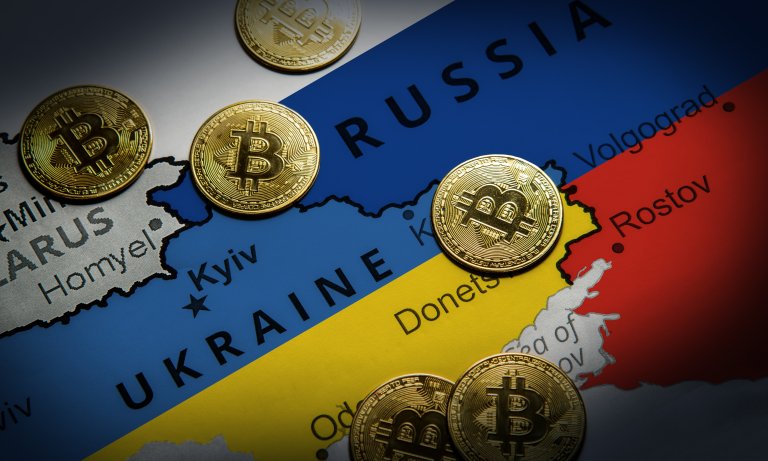Sanctions, Aid, and Bitcoin: Lessons from the Ukraine War
Pundits feared Bitcoin would help Putin evade sanctions. Did it?

Sarah Kreps is a Professor and Director of the Tech Policy Institute at Cornell University and a Senior Fellow at the Bitcoin Policy Institute.
When the Ukraine War began in 2022, the West issued a robust set of sanctions against Russia. Almost immediately, a chorus of criticism emerged about the possibility that Russia could use cryptocurrency to evade sanctions, using cryptocurrencies such as Bitcoin to conduct cross-border transactions that would make it possible for Russia to finance its war machine while making it difficult to trace and monitor the financial flows.
In March 2022, Senator Elizabeth Warren (D-MA) introduced the Digital Assets Sanctions Compliance Enhancement Act to close what she saw as the loopholes that might allow Russian oligarchs to evade sanctions by utilizing cryptocurrencies. As Warren said in defense of the legislation, "Putin and his cronies can move, store, and hide their wealth using cryptocurrencies, potentially allowing them to evade the historic economic sanctions the U.S. and its partners across the world have levied in response to Russia's war against Ukraine."
As Congress has continued its investigation of cryptocurrencies this summer, and how cryptocurrencies should be regulated, an assessment of whether the initial concerns have been proven right or wrong remains timely. To make this assessment involves both a technical question of feasibility along with the empirical question of how either Russia or Ukraine has used crypto for transactions since the war began.
First, on the technical feasibility, many of the early concerns misconstrued the way cryptocurrency functions. To finance a war effort, massive amounts of cryptocurrency would have needed to be exchanged. It is decentralized, which means it is not controlled by the Federal Reserve or Treasury, and is pseudononymous., which is why skeptics were concerned that Russian officials could use crypto to finance the war machine. But anonymous does not mean that sanctioned actors can make transactions without being noticed. Government officials have been on the prowl for large transactions which can often be tracked to individuals, much as they were to a notorious couple who laundered billions in cryptocurrency, raising flags and leading to their arrest.
Second, the liquidity in crypto exchanges is insufficient to accommodate the large transfers of money that would be necessary to be useful in a war effort. For example, the whole crypto market is about $2 trillion and Russia would need hundreds of billions of dollars. The Treasury's cybersecurity head, Todd Conklin, acknowledged that "you can't flip a switch overnight and run a G-20 economy on cryptocurrency. There just isn't enough liquidity."
Third, even though crypto markets are decentralized, many exchanges have physical locations that make them susceptible to government pressure out of concern that if they do not comply with sanctions, they will be sanctioned or regulated themselves, an outcome they have incentives to avoid. In August 2022, the US Treasury's Office of Foreign Assets Control blacklisted Tornado Cash from American use, arguing that the cryptocurrency mixer had obscured trails of funds and enabled illicit activity, including that linked to a North Korean state-backed hacking group. As one analyst concluded after this incident, "it became very clear that crypto needs to pay attention to sanctions and the consequences of not doing it can be significant."
In this vein, Coinbase, for example, whose exchanges are based in the US, had initially asserted that its approach to decentralized finance should fall outside the international sanctions regime but then changed course and wrote that it was "committed to complying with sanctions. And governments are best placed to decide when, where, and how to apply them." Crypto off-ramps provide law enforcement ample opportunity to intercept or seize funds at the point an actor would hope to convert crypto to fiat currency, providing levers of influence that might not eliminate uses of crypto that run afoul of sanctions but at least reduce the incentives these exchanges might have to look the other way.
The question then is whether these assertions about the difficulty of sanctions evasion have the weight of evidence or whether the skeptics have been right.
In April of 2022, the Wall Street Journal had reported that daily ruble trading in cryptocurrencies went to $46 million after the invasion but quickly dropped to $7 million. These trading volumes indicate that Russia has not gone down the feared path of paying for the war effort through crypto transactions. Even if some of the wealthy elite leveraged crypto in the wake of the invasion, the activity has not been sustained over time at least not at those initially meaningful levels.
Rather, the weight of evidence suggests that Ukraine rather than Russia has benefited from cryptocurrency. Crypto exchange web traffic shows that after the country legalized crypto on February 18, 2022, exchange traffic surged 30% in May and remained considerably higher than traffic for Russia, putting it third on Chainalysis' 2022 Global Crypto Adoption Index. The measure is based on cryptocurrency value weighted by purchasing power parity per capita. Ukraine is ranked third after Vietnam and the Philippines (two ahead of the United States and 6 ahead of Russia).
In interviews with Ukrainians, Bitcoin provided a hedge against the distinct possibility of a Ukrainian banking system collapse. While the system did not collapse entirely, it was non-functional for a few days immediately following the invasion, such that crypto became a way for average Ukrainians, who could not simply set up a foreign bank account, to transfer funds out of Ukraine for financial safety or to evacuated family members. In the end, fiat currency was mostly fine, but the advantage of Bitcoin is that it allowed individuals to raise funds and transfer those funds across borders. One individual I spoke with raised $150,000 on Twitter that they then transferred into Ukraine via bitcoin, which was then easy to use for the intended purposes in the country.
Suggesting that Ukraine has benefited more from cryptocurrency than Russia should not imply that the initial concerns were entirely unfounded. Coindesk reported that donations still continue to supply the Russian army, with the Nororussia Aid Coordinating Center (NACC) raising $1.8 million in crypto for surveillance drones, vehicles, and clothing, but that amount pales in comparison to the amounts raised by pro-Ukraine groups.
The United States has supported Ukraine with billions in military and financial aid. It should recognize that the ability to transfer funds and maintain financial independence through digital assets like Bitcoin is a form of aid in and of itself and that undo focus on the misuses of crypto does a disservice to these legitimate uses.



.svg)



.png)
%20copy%205.png)
